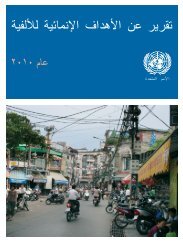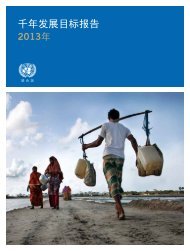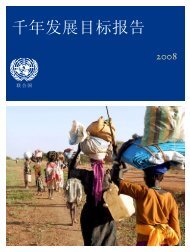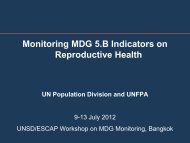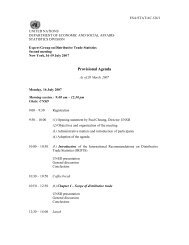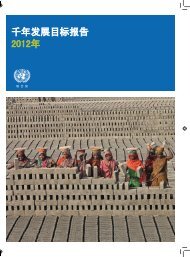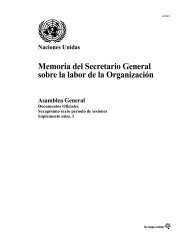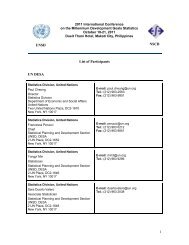demographic yearbook annuaire demographique 1951
demographic yearbook annuaire demographique 1951
demographic yearbook annuaire demographique 1951
Create successful ePaper yourself
Turn your PDF publications into a flip-book with our unique Google optimized e-Paper software.
are given in footnotes. Information on special classes, wherever<br />
available, is also given in footnotes, with an indication<br />
as to whether the figures have or have not been included in<br />
the major categories. Frontier traffic (the 'movement of<br />
persons residing in the frontier areas, moving frequently<br />
across the border and often authorized to use simplified<br />
documents or "frontier cards"') has been excluded from<br />
table 30 though data relating to frontier traffic for the two<br />
countries that supplied them are shown in footnotes.<br />
Thedata on emigrants and immigrants presented in tables<br />
31 to 34 vary considerably around the central concept of<br />
permanence. For example, the figures for a few countries<br />
relate to all passengers without distinction. These figures<br />
include persons who would not be called migrants by most<br />
definitions. How useful an index of migration such data<br />
constitute for a given time and country remains for the user<br />
to determine in each case, until it has become possible to<br />
publish more readily comparable data.<br />
In certain countries the statistics refer to both aliens and<br />
nationals; sometimes separate figures are given for each of<br />
these two categories. Many countries include only nationals<br />
or only aliens. Other limitations restrict the comparability<br />
of the total numbers of migrants: inter-continental, or continental,<br />
migrants only; exclusion of persons travelling by<br />
air; exclusion of persons of certain races etc. These limitations<br />
have been recorded in footnotes to the tables whenever<br />
they were apparent in the source documents.<br />
A fundamental difficulty affecting the comparability of<br />
statistics of international migration lies in the diversity of<br />
sources from which the data are drawn. The following are<br />
the chief kinds of sources represented in the statistics of<br />
emigrants and immigrants shown in tables 31 to 34: (I) port<br />
statistics, (II) frontier control, (III) registration coupons,<br />
(IV) transport contracts, (V) passport records and (VI)<br />
local registers of population. The origin of the statistics is<br />
given in the tables for each country.<br />
Some uniformity in the methods of collection would<br />
clearly improve the comparability of the statistics. However,<br />
in order to obtain comparable statistics, these methods<br />
should be equivalent rather than identical. In an island<br />
country, port statistics may give results comparable to frontier<br />
statistics in a country having only land borders. The<br />
latter type of statistics may, under certain conditions, be<br />
comparable with statistics from population registers. Only<br />
a detailed study of each case may reveal the reliability of<br />
the figures and how comparable they may be between countries<br />
and times.<br />
A common instance of variations in administrative practices<br />
which severely limit the comparability of classifications<br />
of migrants is in the recording of information on the country<br />
of intended residence (or of last residence). Some countries<br />
do not register the country of intended (or of last) permanent<br />
residence, but merely the country of intended (or of last)<br />
residence, which might well be a country of transit. A small<br />
number of countries classify immigrants by country of birth<br />
or by country of citizenship, instead of by country of last<br />
residence. There is a correlation between these classifications;<br />
but the degree of correlation depends on the circumstances<br />
of place and time. It cannot be investigated except<br />
in the very rare cases where two or more types of classifications<br />
are given together. In view of the almost complete lack<br />
of uniformity in the designations found in the sources, the<br />
footnotes to tables 31 and 32 give whatever indication was<br />
obtainable on the meaning of country of intended residence<br />
of emigrants and of country of last residence of immigrants.<br />
It is natural to examine also how well, for a given year,<br />
the number of emigrants leaving a country E for a country I<br />
coincide with the number of immigrants in country I recorded<br />
as arriving from country E. This would require comparability<br />
of a higher degree of perfection than has been<br />
considered hitherto in this text. It is not surprising, therefore,<br />
that the corresponding figures from tables 31 and 32<br />
should differ considerably for most pairs of countries. In<br />
itself this fact does not imply. that the data lack in reliability<br />
and comparability to the point of being of little or no value.<br />
On the contrary, in order that corresponding emigration<br />
and immigration figures should be even approximately<br />
equal for any two countries, so many difficult conditions<br />
would have to be met that equality should not be expected,<br />
for the time being at least. The principal of these conditions<br />
are: equivalence in all countries of methods of collection<br />
and of the definition of immigrant and emigrant; identity<br />
of time references of the data; compatibility of the respective<br />
lists of countries of intended residence and of countries of<br />
last residence. Less fundamental conditions would also have<br />
to be satisfied, such as recording of persons changing their<br />
destination en route and of births and deaths during the<br />
period of travel; adjustment of the data for differences in<br />
the time references of the questions put to the migrants at<br />
the places where the data are collected, so as to deal with<br />
journeys extending beyond the end of a calendar year. However,<br />
even where all these conditions are not fulfilled, the<br />
data may be still useful for many purposes involving more<br />
limited international comparability. Where apparent discrepancies<br />
in corresponding figures are known to arise from<br />
a failure to meet one or other of these conditions an explanatory<br />
footnote is appended.<br />
Tables 31 to 34 continue, up to 1950, the series appearing<br />
in previous editions of the Yearbook. Data for 1945-1947<br />
have been omitted this year and consequently several countries<br />
which had been included in previous editions, but for<br />
which more recent data cannot be presented, do not appear<br />
in these tables. In addition, Switzerland has been omitted<br />
from tables 32 and 34 because these data are no longer<br />
compiled.<br />
In tables 31 and 32, which present data for 16 areas, the<br />
total number of emigrants (or immigrants) shown for each<br />
country is the sum of the sub-totals by continents and of<br />
the figure for "unknown" destinations (or origins). However,<br />
the sub-total for a continent is not necessarily the sum<br />
of the figures given for the countries of that continent since<br />
it may also include figures for countries not listed individually.<br />
In those cases where there are significant numbers<br />
of migrants going to (or coming from) a country not listed<br />
in the stub the details are given in a footnote.<br />
Data on migrants by age and sex are shown in tables 33<br />
and 34 for 14 and 13 areas respectively. For most of the<br />
countries data are available in 5-year age groups up to 29<br />
years and in la-year age groups from 30 to 59 years. However,<br />
practices vary and in some cases only broad agegroups,<br />
corresponding to children and adults, are available.<br />
A more comprehensive compilation of migration statistics<br />
by age and sex covering the period 1918-1947 is now in<br />
preparation in the Social Affairs Department of the United<br />
Nations.<br />
39





